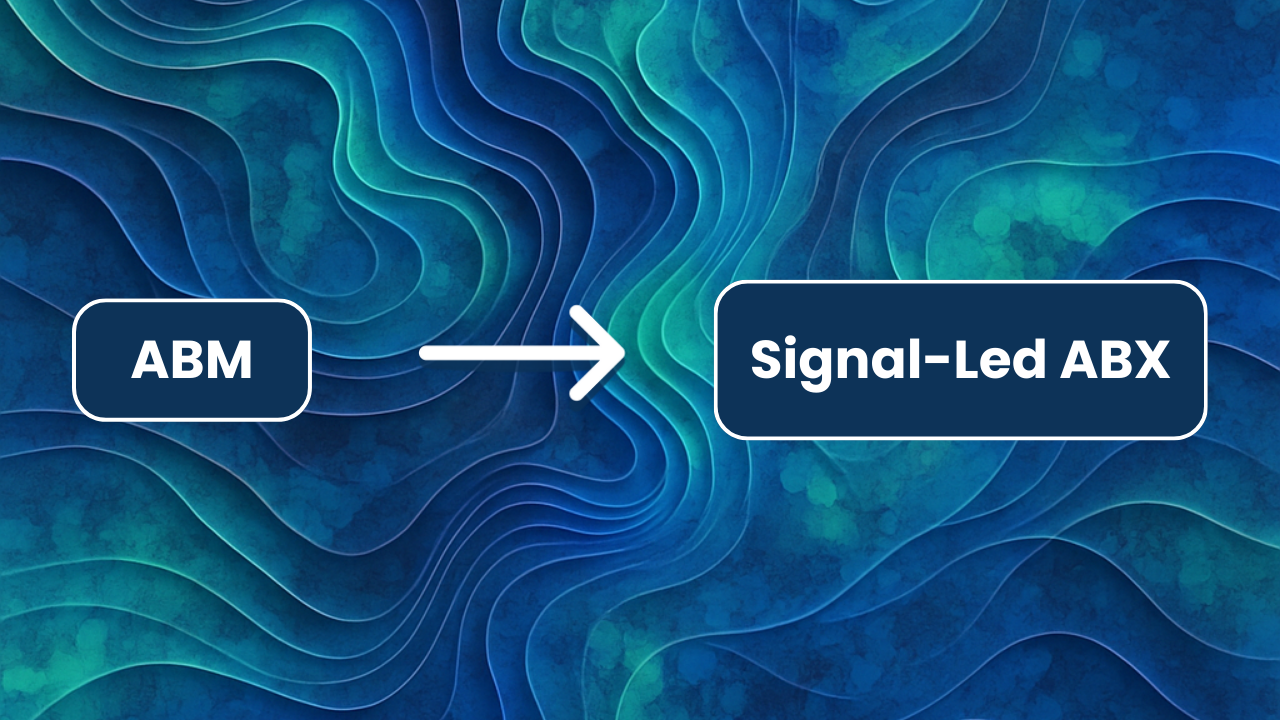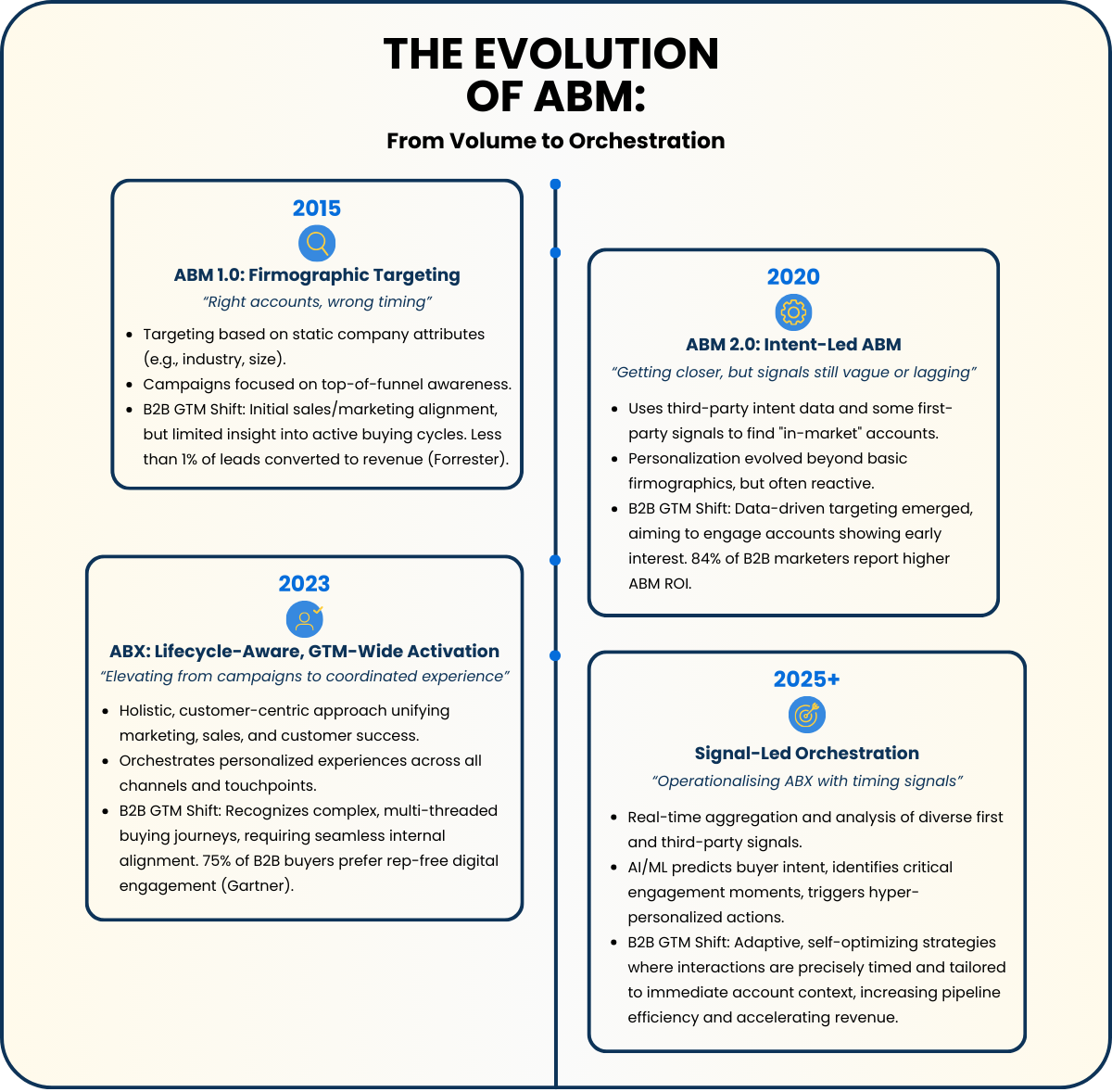
For years, Account-Based Marketing (ABM) has been a cornerstone for B2B growth. But in 2025, strategies that revolve around ideal customer profiles (ICPs) and intent data are showing cracks.
The problem? You’re often showing up too early, too late, or in the wrong way.
What’s working now isn’t just identifying who to target. It’s knowing when, why, and how to engage. It comes from signal-led ABX (Account-Based Experience), powered by subscription intelligence. At MarketSizer, we deliver real-time, evidence-based signals like competitor trials, renewal windows, and churn risks so GTM teams can orchestrate smarter moves across marketing, sales, and customer success.

ABM has had a good run. But the truth is, what worked a decade ago can’t keep up with today’s buying dynamics. Let’s take a quick tour through its evolution.
2015 – ABM 1.0: Firmographic Targeting
Think back to the early days. We were picking accounts based on surface-level stuff like industry, size, and geography. Did it narrow the focus? Sure. Did it drive real results? Not really. Most teams ended up chasing “the right accounts” at completely the wrong time. It was like knocking on someone’s door when they weren’t even home.
2020 – ABM 2.0: Intent-Led ABM
Intent data looked like a breakthrough. By tracking content downloads, search activity, or ad clicks, companies thought they’d cracked the code to finding “in-market” accounts. But here’s the problem: intent signals were often lagging, inferred, or noisy. Teams invested heavily in accounts that looked warm but never converted.
2023 – ABX: Experience Takes Center Stage
By 2023, companies realized that success wasn’t just about acquisition. Growth also depended on retention and expansion. Enter ABX, Account-Based Experience, a shift toward lifecycle-wide engagement. Marketing, sales, and CS started working together to orchestrate better experiences. Progress, yes. But without clear signals, orchestration was still reactive.
2025+ – Signal-Led Orchestration
This is where we are today. Signal-led orchestration is ABX finally operating at full power. Instead of relying on lagging intent data, GTM teams are using real-time, evidence-based signals like knowing when a prospect is trialing Zendesk or Freshdesk, when a renewal is coming up, or when a customer’s adoption hints at an expansion opportunity. It’s sharper, simpler, and synced across every GTM motion.
👉 In short: no more guesswork, no more wasted plays.
Here’s the hard truth: intent data and ICPs don’t tell the whole story. They leave GTM teams blind to what really matters: timing.
If you’re selling customer support software, that blindness shows up like this:
The cost? Wasted budget, lost deals, and higher churn.
MarketSizer fixes this. By surfacing real subscription data in real time, we eliminate the blind spots. Instead of waiting until it’s too late, your teams know exactly when to move.
At MarketSizer, we call this shift GTM Signal Intelligence and it’s a whole new way of running go-to-market.
Here’s what makes it different:
For customer support software vendors, that means:
Signal-led ABX transforms GTM from scattered plays to coordinated execution. Imagine this:
👉 The result? A synchronized GTM team delivering a coordinated customer experience across the lifecycle.
Here’s why this matters right now: the buying cycle has sped up. AI-driven tools, rep-free research, and digital-first journeys mean decisions get made faster and often without you in the room.
If you’re still relying on static ICPs or lagging intent data, you’re already behind. Competitors that use subscription intelligence are:
The shift to signal-led orchestration isn’t a nice-to-have in 2025, it’s the cost of staying competitive.
Every team falls somewhere on this journey:
👉 Check out the Evolution of ABM infographic to see where your team sits and where you need to go next.

1. What is the difference between ABM and ABX?
ABM targets accounts. ABX orchestrates the entire customer journey. With MarketSizer, ABX becomes signal-led powered by real subscription intelligence.
2. Why is intent data outdated in 2025?
Intent signals are often vague and lagging. Subscription intelligence delivers real-time evidence of what accounts are actually doing.
3. How does GTM Signal Intelligence improve ABM?
It eliminates guesswork. By surfacing live subscription activity, MarketSizer helps GTM teams act with precision and confidence.
4. What are timing signals in GTM?
Competitive trials, renewal windows, expansion adoption, all the moments when timing determines whether you win or lose.
5. How do I know if my team has signal blindness?
If you’re overspending on bad accounts, losing to competitors you didn’t see coming, or getting blindsided by churn, you’re signal blind.